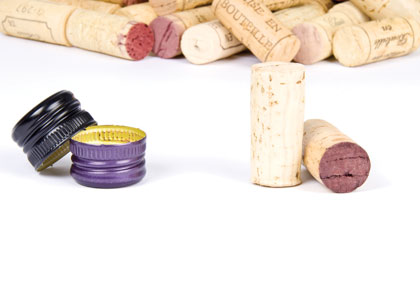To Cork or Cap

Audio By Carbonatix

Taking a closer look at the ever so debated…screw-cap!
by Ertan Sener
One day, as I began to think about possible topics for this article, I was opening a bottle of my favorite Prosecco. While the thoughts whirled through my head I began to open the bottle in hand. I didn’t have to remove any foil or any cage; there was no twisting and turning of the knob of a cork stopper. I actually reached for a bottle cap opener and carefully pried the crown cap (yes, like a beer cap) off the top of the bottle to the sound of the bottle’s sigh of relief. The thought came to me that I would have to now convince certain customers that this IS quality Prosecco, which I never needed to do back when it had a different closer…a CORK. Well, my topic was found and I would like to take the time to compare and contrast the closures of wine bottles, as we know them. Taking a closer look at the ever so debated (thunder clap!)…THE SCREW-CAP!
First let us examine the age-old friend to wine closures…the cork. Cork comes from a relatively young species of Oak Tree. It needs very specific climate as well as other growing conditions to survive. That is why we find the majority of cork trees on the coast of the western Mediterranean, such as Spain, North Africa and much of Portugal where growing conditions are ideal. Cork production and exportation is very important to the Portuguese Economy. A third of the world’s cork oak concentration is in Portugal, covering over 1.6 million acres! The cork tree is very unique, where you can actually remove, or strip its bark from the trunk and branches without hurting the tree, This is where the cork stoppers are plugged from, the thick strips of bark. The cork tree needs to be in its 25th year in order for it to produce commercially viable cork. That seems a long time, but the life of a cork tree is about 170 years, without the stripping process taking away from this number. Record had been kept that some trees have lived over 200 years. Well from these trees comes a curious material used in many industries, but has passed the hands of many of us as the common cork closure.
Egyptians used cork, as we do today, to close wine bottles as far back as thousands of years ago. Fifth Century BC, corks were used by the Greeks, and defiantly early on by the Romans. Why is cork a sound closer for wine? Well, the structure of cork is very unique. It consists of closely packed, 14 sided cells, this rendering its light, elastic quality. It is very impermeable to gases and most liquids, not so effective to those with strong acids. Corks are, and should be an airtight closure. A very interesting article in Appellation America.com, entitled “Please Stop Telling People Corks ‘Breathe’, by Richard Grant Peterson, Ph.D., February 10, 2008, Grant says, “Show me a cork that breathes and I’ll show you a bottle of vinegar.” Well then, why are there so many closures being developed to replace the use of cork? Oooh…very good question! Even though cork is a great way to close a bottle of wine, it being a natural product, there could be inconsistencies and/or possible faults or imperfections. Let us look at a few of the more important ones to understand.
If a wine bottle is not stored correctly, it could dry out the cork and let oxygen in, which is bad. If the cork was not put in correctly, there might be some seepage, which could let some air in, and we know, that would be bad. But the worst thing happens to a corked bottle of wine. Let me define what corked wine actually means, and this is not the fault of the cork! It happens in the sterilization process of the corks, and it is a chemical reaction. A nasty little resultant, 2,4,6-Trichloranisole, or as it is more commonly referred to as TCA. Have you ever opened a favorite bottle of wine, pour a glass, take a big sniff and…POW, you get slapped in the face with the smell of wet newspaper, moldy cardboard or basement floor! Well this is no good! This is TCA, and has nothing to do with the quality of the wine, it is a reaction process due to the cleaning of the cork and that damaged the wine. This is important to know if this happens to you in a restaurant. Just ask for a new bottle. This is the main reason the search for a more practical closure started in our modern age. The most popular being the Stelvin Closure, a.k.a. the screw-cap!
Well the Stelvin Closure was created to save the wine from the taint of TCA, and it was designed to resemble the traditional cork closure, with its long skirt, resembling the foil of a traditional cork closer. But where is the romance with the twist and turn of the screwcap? Oh please. Let’s grow up. It’s about the wine. It’s about getting the wine from the bottle to the glass and to your lips with the pleasing of possibilities. What is romantic about sticky wine? Nothing! That Stelvin Closure comes with a promise, that wine is what it is and has not been affected by TCA! Sounds good to me! It is great to see so many wonderful producers of wine excepting this method of closure. To uphold what the bottle holds and protects…the wine!



